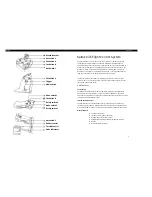
CHAPTER 5: SETTINGS
CONTROL ELEMENTS
L30 LINE CURRENT DIFFERENTIAL SYSTEM – INSTRUCTION MANUAL
5-275
5
SYNCHK1 V2 ANGLE SHIFT
— Specifies the angle of source V2 that needs to be shifted so that V2 angle can be directly
compared with V1 angle. For example, when V1 and V2 are taken from two different windings of the transformer and with
different angle shift due to winding connections, the angle shift compensation must be performed before starting angle
comparison in synchrocheck element.
SYNCHK1 DEAD SOURCE SELECT
— Selects the combination of dead and live sources that bypass the synchronism check
function and permit the breaker to be closed when one or both of the two voltages (V1 or/and V2) are below the maximum
voltage threshold. A dead or live source is declared by monitoring the voltage level. Six options are available:
None — Dead Source function is disabled
LV1 and DV2 — Live V1 and Dead V2
DV1 and LV2 — Dead V1 and Live V2
DV1 or DV2 — Dead V1 or Dead V2
DV1 Xor DV2 — Dead V1 exclusive-or Dead V2 (one source is Dead and the other is Live)
DV1 and DV2 — Dead V1 and Dead V2
SYNCHK1 DEAD V1 MAX VOLT
— Establishes a maximum voltage magnitude for V1 in 1 ‘pu’. Below this magnitude, the V1
voltage input used for synchrocheck is considered “Dead” or de-energized.
SYNCHK1 DEAD V2 MAX VOLT
— Establishes a maximum voltage magnitude for V2 in ‘pu’. Below this magnitude, the V2
voltage input used for synchrocheck is considered “Dead” or de-energized.
SYNCHK1 LIVE V1 MIN VOLT
— Establishes a minimum voltage magnitude for V1 in ‘pu’. Above this magnitude, the V1 voltage
input used for synchrocheck is considered “Live” or energized.
SYNCHK1 LIVE V2 MIN VOLT
— This setting establishes a minimum voltage magnitude for V2 in ‘pu’. Above this magnitude,
the V2 voltage input used for synchrocheck is considered “Live” or energized.
Notes on the synchrocheck function
1.
The selected sources for synchrocheck inputs V1 and V2 (which must not be the same source) can include both a
three-phase and an auxiliary voltage. The relay automatically selects the specific voltages to be used by the
synchrocheck element in accordance with the following table.
The voltages V1 and V2 are matched automatically so that the corresponding voltages from the two sources are used
to measure conditions. A phase to phase voltage is used if available in both sources; if one or both of the Sources have
only an auxiliary voltage, this voltage is used. For example, if an auxiliary voltage is programmed to VAG, the
synchrocheck element automatically selects VAG from the other source. If the comparison is required on a specific
voltage, the user can externally connect that specific voltage to auxiliary voltage terminals and then use this "Auxiliary
Voltage" to check the synchronism conditions.
If using a single CT/VT module with both phase voltages and an auxiliary voltage, ensure that only the auxiliary
voltage is programmed in one of the sources to be used for synchrocheck. An exception is that synchronism cannot
be checked between Delta connected phase VTs and a Wye connected auxiliary voltage.
2.
The relay measures frequency and Volts/Hz from an input on a given source with priorities as established by the
configuration of input channels to the source. The relay uses the phase channel of a three-phase set of voltages if
programmed as part of that source. The relay uses the auxiliary voltage channel only if that channel is programmed
Number
V1 or V2 (source Y)
V2 or V1 (source Z)
Auto-selected combination
Auto-selected
voltage
Source Y
Source Z
1
Phase VTs and
Auxiliary VT
Phase VTs and
Auxiliary VT
Phase
Phase
VAB
2
Phase VTs and
Auxiliary VT
Phase VT
Phase
Phase
VAB
3
Phase VT
Phase VT
Phase
Phase
VAB
4
Phase VT and Auxiliary
VT
Auxiliary VT
Phase
Auxiliary
V auxiliary
(as set for source Z)
5
Auxiliary VT
Auxiliary VT
Auxiliary
Auxiliary
V auxiliary
(as set for selected
sources)
Содержание L30
Страница 10: ...x L30 LINE CURRENT DIFFERENTIAL SYSTEM INSTRUCTION MANUAL TABLE OF CONTENTS ...
Страница 14: ...1 4 L30 LINE CURRENT DIFFERENTIAL SYSTEM INSTRUCTION MANUAL FOR FURTHER ASSISTANCE CHAPTER 1 INTRODUCTION 1 ...
Страница 126: ...3 68 L30 LINE CURRENT DIFFERENTIAL SYSTEM INSTRUCTION MANUAL CONNECT TO D400 GATEWAY CHAPTER 3 INSTALLATION 3 ...
Страница 214: ...4 88 L30 LINE CURRENT DIFFERENTIAL SYSTEM INSTRUCTION MANUAL FLEXLOGIC DESIGN USING ENGINEER CHAPTER 4 INTERFACES 4 ...
Страница 582: ...7 16 L30 LINE CURRENT DIFFERENTIAL SYSTEM INSTRUCTION MANUAL TARGETS MENU CHAPTER 7 COMMANDS AND TARGETS 7 ...
Страница 598: ...9 6 L30 LINE CURRENT DIFFERENTIAL SYSTEM INSTRUCTION MANUAL TESTING CHAPTER 9 COMMISSIONING 9 ...
Страница 622: ...10 24 L30 LINE CURRENT DIFFERENTIAL SYSTEM INSTRUCTION MANUAL FAULT LOCATOR CHAPTER 10 THEORY OF OPERATION 10 ...
Страница 670: ...A 18 L30 LINE CURRENT DIFFERENTIAL SYSTEM INSTRUCTION MANUAL FLEXANALOG ITEMS APPENDIX A FLEXANALOG OPERANDS A ...
Страница 678: ...C 6 L30 LINE CURRENT DIFFERENTIAL SYSTEM INSTRUCTION MANUAL COMMAND LINE INTERFACE APPENDIX C COMMAND LINE INTERFACE C ...
Страница 682: ...D 4 L30 LINE CURRENT DIFFERENTIAL SYSTEM INSTRUCTION MANUAL REVISION HISTORY APPENDIX D MISCELLANEOUS D ...
Страница 686: ...iv L30 LINE CURRENT DIFFERENTIAL SYSTEM INSTRUCTION MANUAL ABBREVIATIONS ...
















































